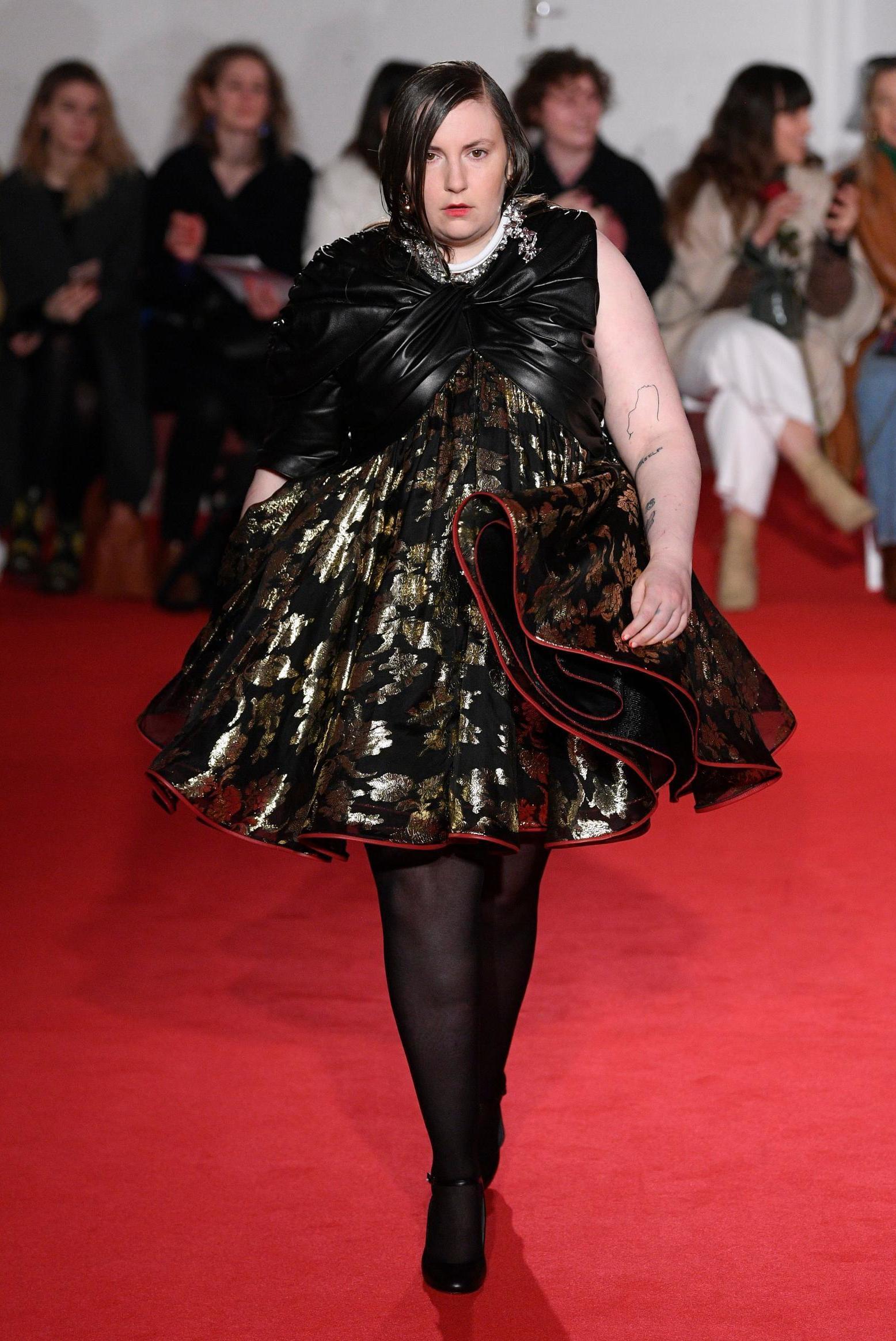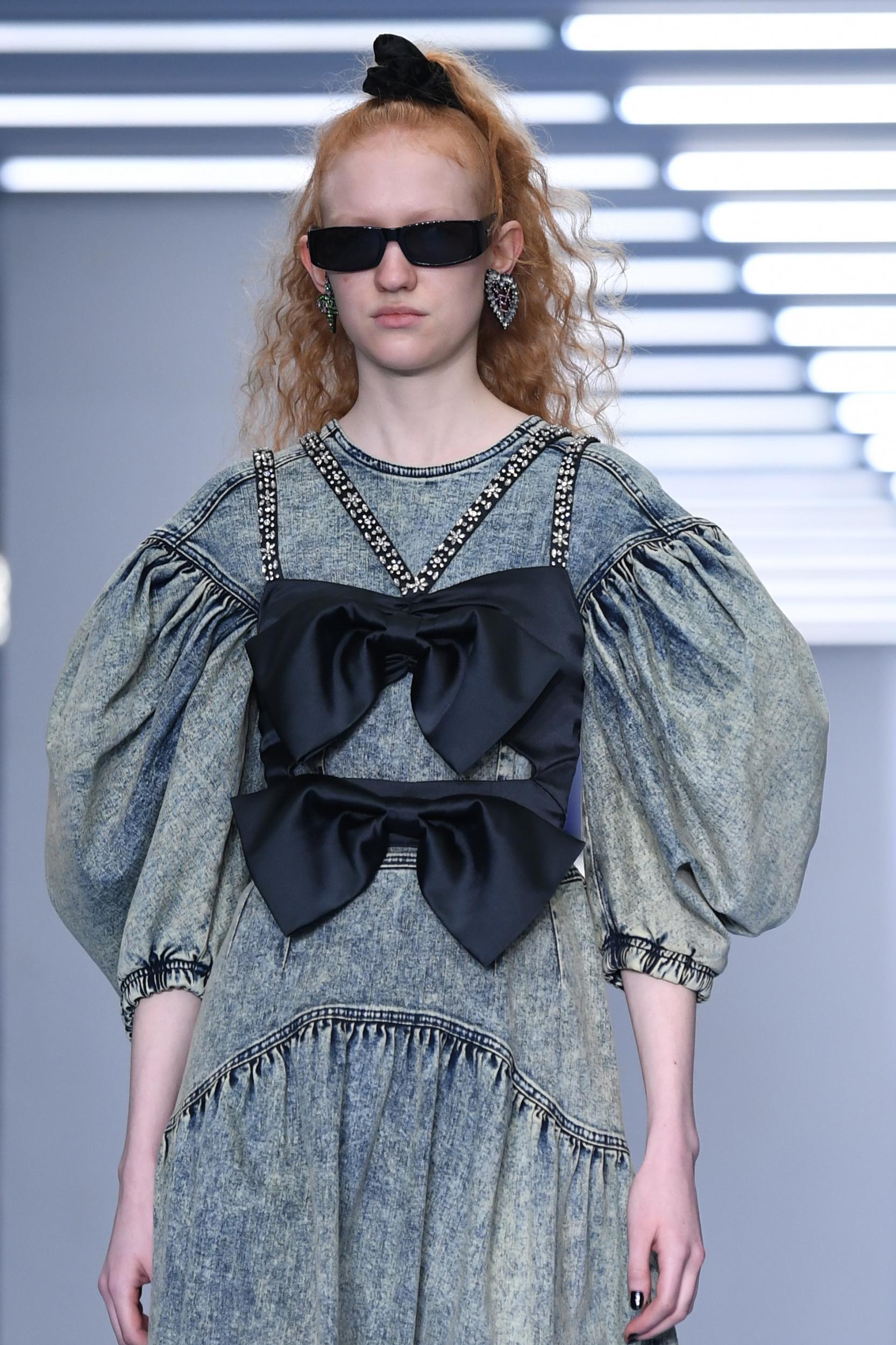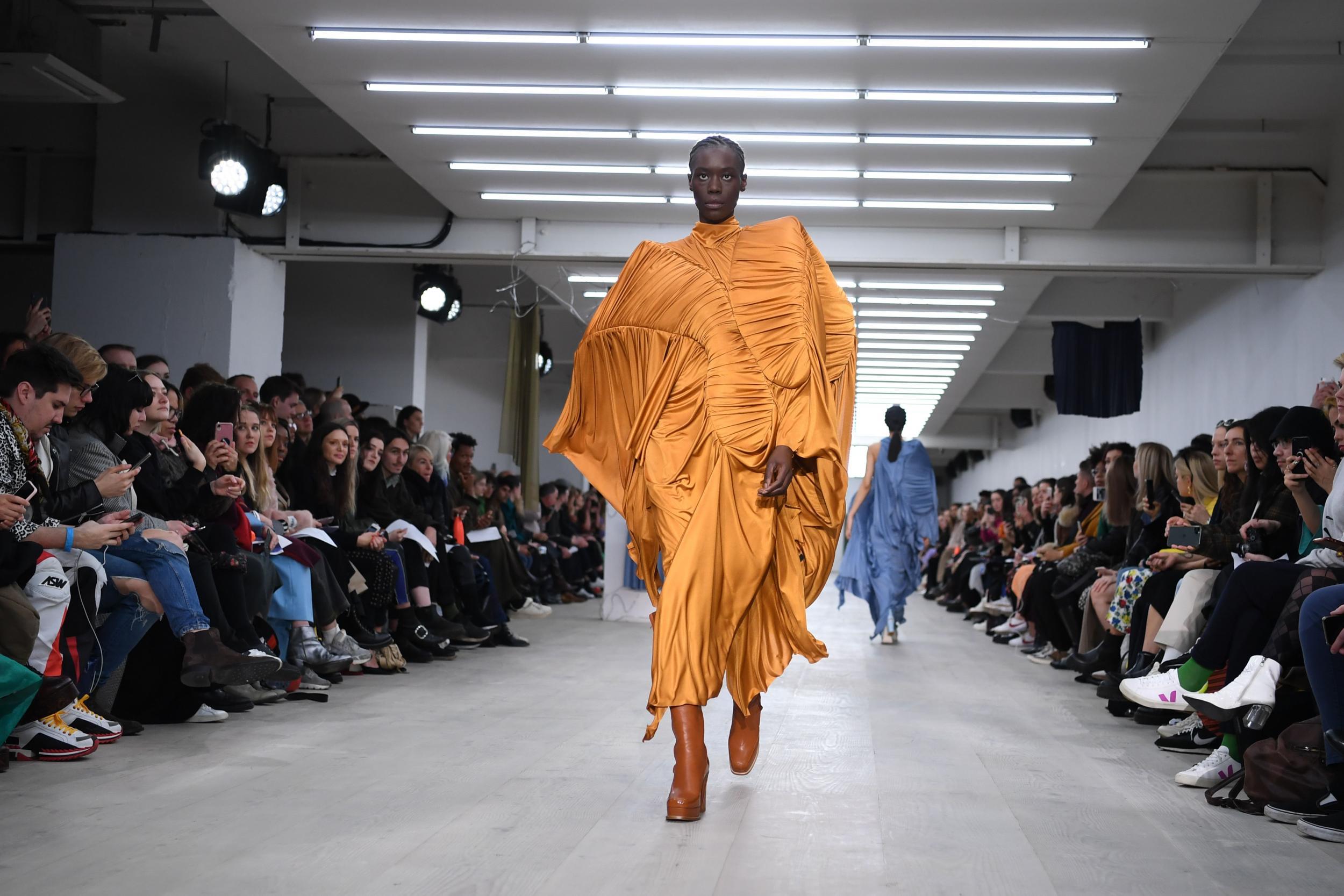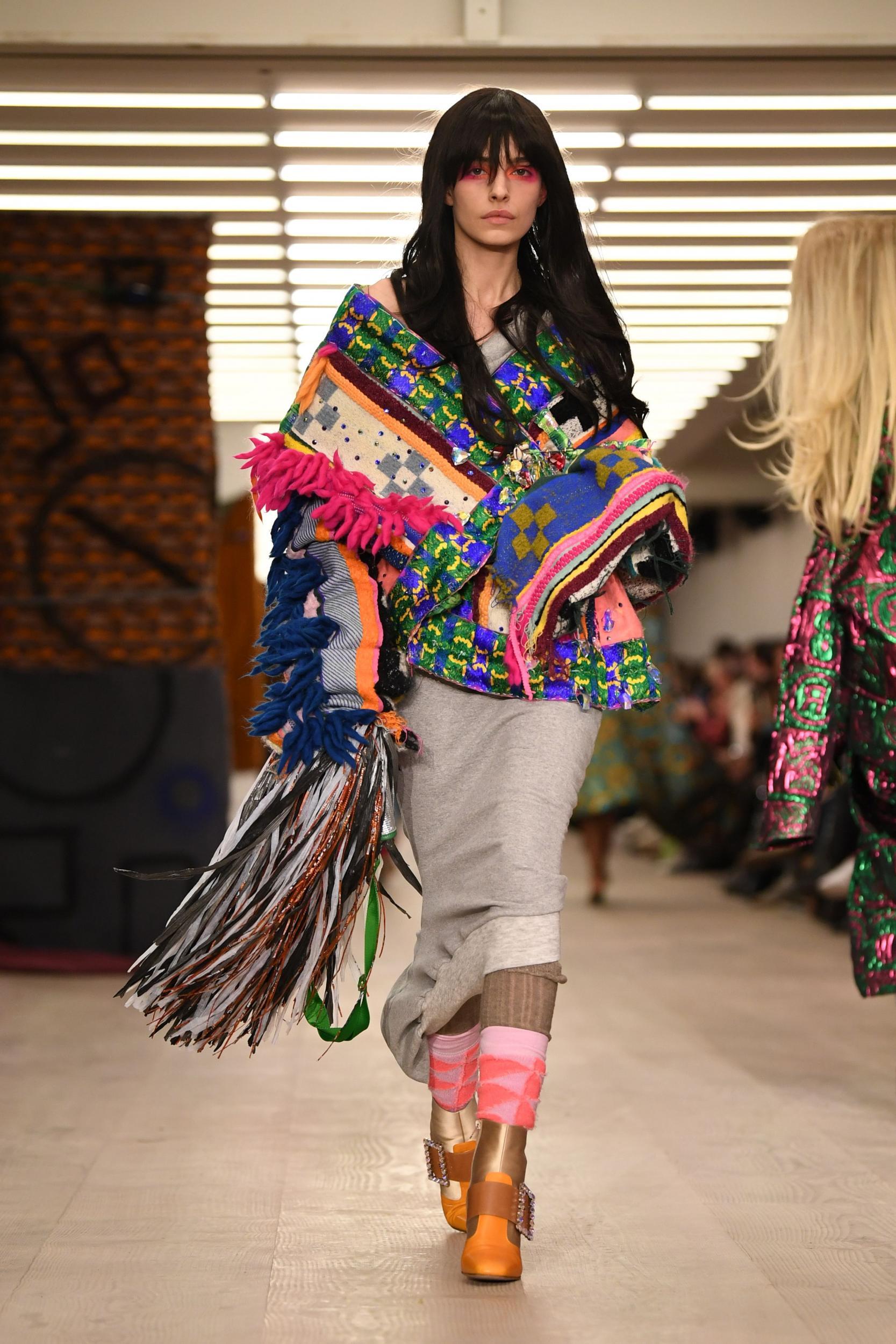London Fashion Week AW20: Lena Dunham took to the catwalk and sustainability was the word on everyone's lips at the first day of shows
Designers are out to prove that the fashion industry can be respectful to the planet without losing its creative edge, says Sarah Young


The time of year that models, buyers, designers and editors have spent months preparing for has returned once more: London Fashion Week is here.
Following in the footsteps of New York, Friday kicked off the five-day-long industry event which showcases some of the industry’s brightest talents as teems of highly-caffeinated journalists and buyers leapfrogged across the capital to see what is in store for the season ahead.
With a focus on fresh talent and new names, the first day of shows at London Fashion Week commenced the capital’s autumn/winter 2020 showcase with a vibrant and varied selection of designers.
But, while the usual hubbub of fashion week was ever-present – the city’s finest street-style slickers still came out to play and window-tinted cars continued to engulf the city – changes are seemingly afoot.
From shows that are open to the public to an increased focus on sustainability and ethical fashion, this season designers are snubbing convention in favour of a sartorial rebirth that proves the industry can be inclusive and respectful to the planet without losing its creative edge.

Fledgling brands and ones to watch dominated the schedule on day one, with highlights including Ashley Williams’ punk-inspired party frocks, Matty Bovan’s typically eclectic prints and Richard Malone’s elevated, structured tailoring: all of which served as compelling and glamorous start to this season’s shows.
Elsewhere, Vivienne Westwood held an art show that doubled-up as a protest in support of WikiLeaks co-founder Julian Assange – who is currently awaiting a hearing that will decide if he’ll be extradited to the United States to face conspiracy and hacking charges – and actor Lena Dunham made her London Fashion Week debut on the runway of 16Arlington as part of the brand’s mission to cast women of all different sizes, heights and races.
Mulberry
Founded in 1971 in Somerset, Mulberry has grown into one of the largest luxury leather goods designers and manufacturers in the UK.
This season, the brand invited guests behind-the-scenes at its flagship store on Bond Street to highlight its love of British craft and the responsibility commitments of its past, present and future.
The immersive installation saw Mulberry’s carbon-neutral Somerset Factories transported to London where attendees could watch on-site craftspeople create the brand’s new Portobello Tote, which Mulberry is claiming to be its first 100 per cent sustainable leather bag.
The event also saw the launch of The Mulberry Exchange comma, a new initiative that invites customers to part exchange their old Mulberry bags for new models as part of a new recycling scheme.
Elsewhere, mannequins lined the room decked out in the brand’s latest “M Collection” which features pieces made with durable and water repellent jacquard made from ECONYL regenerated nylon and sustainable cotton.
This season, the brand’s commitment to promoting sustainability and keeping British craft at its heart appeared genuinely thought through and served as a reminder of the need for more consumer brands, and the fashion industry as a whole, to do the same.
Ashley Williams

“Use a cheese grater to display your jewellery, wear your slippers as earrings and walk backwards through a hedge”: that, according to Ashley Williams’ show notes, is how to re-create her signature autumn/winter 2020 look.
One of Britain’s most talked about womenswear designers, Williams perfectly captures the irreverent and rebellious tone of London Fashion Week and this season, with her uber-cool girl crew in tow – Pixie Geldof walked the runway – she proved that no-one toes the line between good and bad taste, quite like she does.
Doing what she does best, Williams reworked vintage shapes with her signature prints and slogans to create a collection inspired by stars of silver screen, including Jessica Rabbit, Thelma and Louise, Cinderella and Poison Ivy.
The collection delivered a number of Williams’ tropes including tourist-inspired T-shirts emblazoned with puppy dog prints and tongue-in-cheek slogans, while mohair granny knits were paired with oversized tulle gowns.
Her now cult sparkly tongue-in-cheek hair pins were also present, of course, but were given new life with words like “weed”, “parasite”, “maggot” and “psycho” sewn into electric blue hair extensions.
This season, the designer touched upon her efforts to become more sustainable too. In collaboration with her friend, artist and designer Claire Barrow, Williams trawled through old samples and dead stock to create a patchwork gown using scraps of surplus fabric.
“We dismantled our past and put it back together in a beautifully wrong way,” explained the designer.
Ultimately, it was Williams’s instantly recognisable visual cues and light-hearted referencing that made the show a hit and cemented her place as one of London Fashion Week’s must-sees.
Richard Malone

Richard Malone might be a relative newcomer to the London Fashion Week schedule but the young Irish designer has already developed a signature for which he is well-known and respected among industry insiders.
Today’s offering was inspired by the spirit of fearless female endeavour and Mary Gabriel’s pioneering book Ninth Street Women.
“The book charts the lives of five female artists who drove a post-war revolution in modern art,” Malone told Vogue. “It served as a powerful reminder of the importance of absolute and utter dedication to ‘the work’, and the new collection.”
The designer’s influence was characterised by short, sharp hits of structured tailoring, asymmetric shoulders, the strange positioning of cut-outs and a new take on last season’s Herculean gowns that were constructed with complicated arrangements of ruched mesh and shoulders so wide they almost touched the knees of those sitting on the FROW.
While sustainability is a novel idea for many designers, for Malone it is an intrinsic part to what he does, and this season was no exception.
For AW20, the designer presented an upcycled jewellery collaboration with Alighieri’s Rosh Mahtani and left guests with double-sided show notes explaining his commitment to “establish a new way of producing fashion”.
Among the innovations, Malone’s latest collection was crafted from regenerative nylon, recycled leather and wools that were dyed using the juice of lotus leaves.
Matty Bovan

As one of the most exciting designers currently rising out of London’s fashion scene, Matty Bovan is one for doing things differently.
In previous seasons, Bovan’s shows have included everything from balloon headdresses and crinoline ballgowns to exuberant leg-of-mutton silhouettes. And while the designer’s wild and wonderful displays of self-expression were evident, his latest collection felt far more, dare we say it, wearable.
The signatures seen in previous collections were dialled down for autumn/winter in favour of textural fabrics, including velvet ripples and woollen piles, while giant hand-appliqued Swarovski crystals adorned Fiorucci denim.
Elsewhere, tulle party dresses and lean pinstripe trousers were paired with cowboy boots while oversized knits in fluorescent brights and distorted florals became the designer’s latest obsession.
Of course, there were moments that Bovan’s creativity bloomed, particularly when it came to pushing silhouettes using angular shapes which he said represented “an out-of-body experience”.
Most notably, this came in the form of custom screens that were attached to the shoulders and skirts of jacquard dresses and adorned with prints excavated from the British Library’s archive to become spatial banners.
Season after season, it is this warped friction between reality and fantasy that makes Bovan’s playful collections so intriguing, but for him these offerings do more than peak our sartorial interest with a “raft of pressing, esoteric questions about the purpose of making fashion in 2020”.
Join our commenting forum
Join thought-provoking conversations, follow other Independent readers and see their replies
Comments